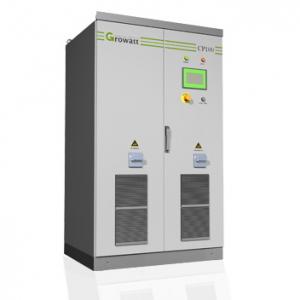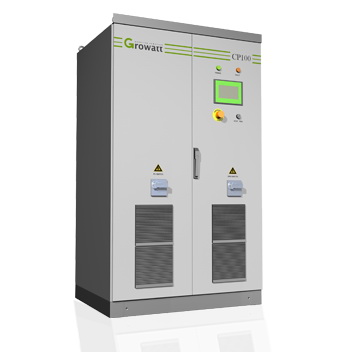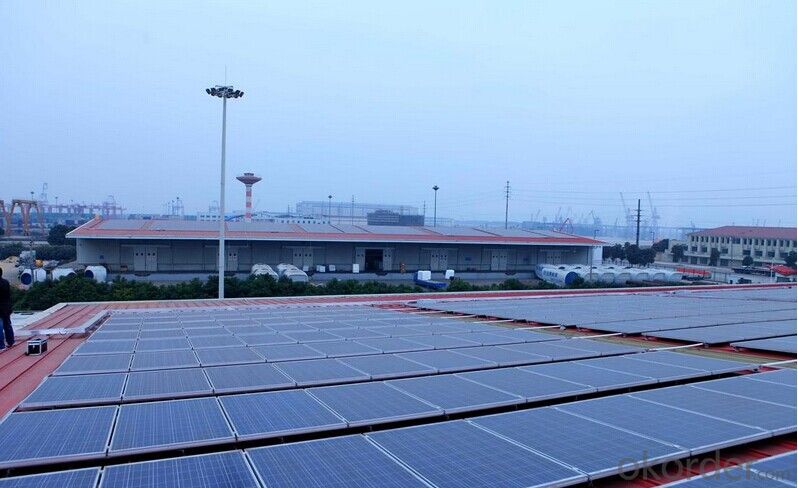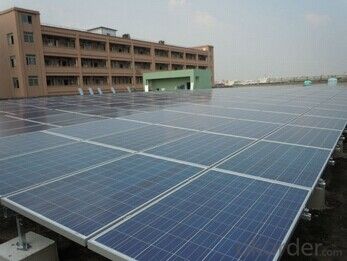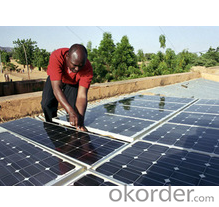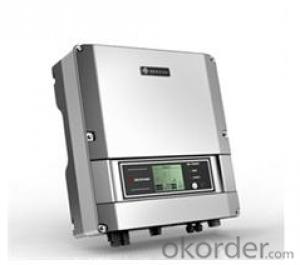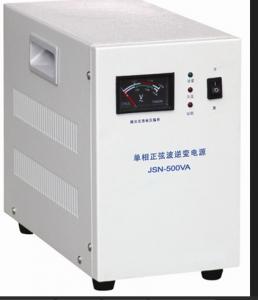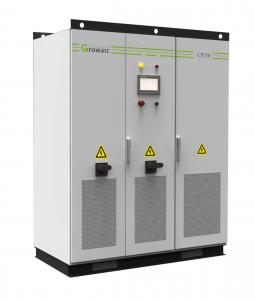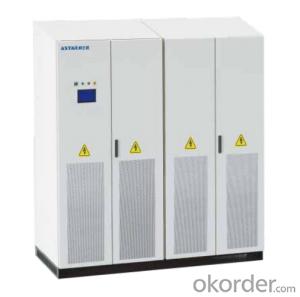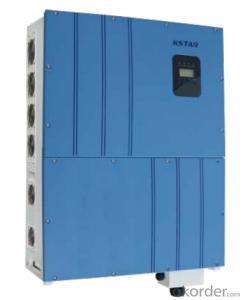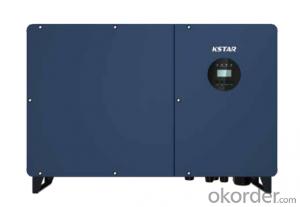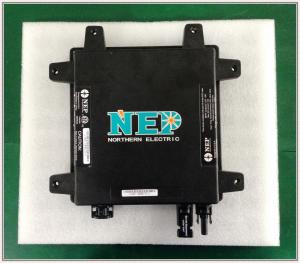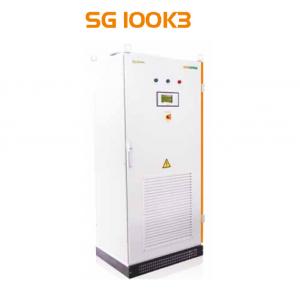PV Grid-Tied Inverter CP100, 100kw, Power Inverter
- Loading Port:
- Shekou
- Payment Terms:
- TT or LC
- Min Order Qty:
- 20 pc
- Supply Capability:
- 10000 pc/month
OKorder Service Pledge
OKorder Financial Service
You Might Also Like
PV grid-tied inverter CP100, 100kw, power inverter
Specifications
Low voltage ride through
Active power continuous adjustment (0-100%)
Reactive power adjustable, PF range 0.9lagging aa 0.9lead
Low voltage ride through
Active power continuous adjustment (0-100%)
Reactive power adjustable, PF range 0.9lagging – 0.9leading
Maximum conversion efficiency of 98.6%
Multi-language touch panel monitoring interface
Rigorous grid environment adaptable
Auxiliary electrical heating (optional)
High altitude application adaptable<6000m (power derating over 3000m)
Certificates and approvals including CE,CGC solar,BDEW etc.
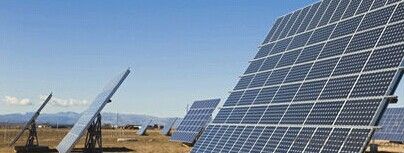
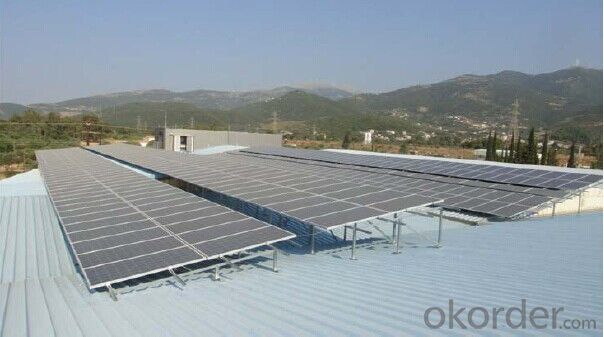
Input Data (DC)
Max. DC voltage | 1000V |
Full-load MPP-Voltage range | 450V-820V |
Nominal DC voltage | 500V |
Max. input current | 250A |
Number of MPP trackers | 1 |
Max. number of parallel strings | 2 |
Nominal AC output power | 100KVA |
Nominal AC output voltage | 400V |
AC output voltage range | 360V-440V |
Nominal AC output frequency | 50Hz/60Hz |
AC output frequency range | 45Hz-55Hz/55Hz-65Hz |
Max.output current | 160A |
PF (cosφ) | 0.9lagging – 0.9leading |
THDI | <3%(@pac,r)< span=""> |
Efficiency
Max. conversion efficiency | 97.5% |
Euro-eta | 96.5% |
MPPT efficiency | 99.9% |
Protection
DC disconnection device | yes |
AC disconnection device | yes |
DC Over-voltage protection | Arrester typeⅡ |
AC Over-voltage protection | Arrester typeⅡ |
Grid monitoring/Regulation | yes/yes |
PV Isolation detection | yes |
eneral Data
Dimension (W/H/D) | 1100/1890/850 mm |
Weight | 1000kg |
Operating temperature range | -20°C … +50°C |
Humidity | 15% - 95% |
Protection level | IP20 |
Noise emission | 65dB(A)@1m |
Altitude | 3000m |
Standby power consumption | <100w< p=""> |
Cooling concept | Forced Air Cooling |
Topology | Industrial Frequency Transformer |
Display | LCD Touch Panel |
Communication interface | RS 485/ Ethernet |
Certificate & Approval
Approval | CE/CQC/TUV/BDEW |
FAQ
1. Have any design tool and how to use it?
Shine Design is the system design software just for inverters, It can conduct installers to figure out panel numbers for a system, panel numbers for each string, and which inverter model is suitable for the system. Moreover, it can print a design report after input all necessary parameters, can calculate DC/AC wire wastage, annual generation, etc.
2. Does the inverter have monitoring solutions for residential system?
For small rating system, we have wired two monitoring solution (ShineNet via RS232 or RS485). (a) Local wireless monitoring solution (ShineVision via RF module communication) (b) Global wireless monitoring solution (WIFI module via WIFI network)
3. Do you have free solution for monitoring?
ShineNet is an inverter monitoring software run in Windows XP, Windows Vista, Windows 7 operating system. It can monitor inverter via RS232 (or RS232 convert to USB cable) and RS485 wire connection. Customers can purchase the cable locally to get the inverter monitored, it is simple.
- Q: How does a solar inverter handle fluctuations in solar panel output?
- A solar inverter handles fluctuations in solar panel output by constantly monitoring the incoming DC power from the panels and adjusting its own output to match the required AC power demand. It utilizes Maximum Power Point Tracking (MPPT) technology to optimize the energy conversion process, ensuring that the inverter extracts the maximum power from the solar panels even if the output fluctuates due to factors like shading or varying sunlight intensity. This allows for a stable and reliable power supply to the electrical grid or connected devices.
- Q: Can a solar inverter be used in systems with multiple solar arrays?
- Yes, a solar inverter can be used in systems with multiple solar arrays. The inverter has the capability to convert the DC power generated by each solar array into AC power that can be used in the electrical system. It can manage and optimize the power output from multiple arrays, ensuring efficient and reliable operation of the overall solar system.
- Q: Can a solar inverter be used with different types of grounding systems?
- Yes, a solar inverter can be used with different types of grounding systems. Solar inverters are designed to be flexible and adaptable to various electrical systems and grounding configurations. They can be used with grounded, ungrounded, or impedance grounded systems, allowing for compatibility across different types of grounding systems.
- Q: How long does it take to install a solar inverter?
- The installation time for a solar inverter can vary depending on various factors such as the size of the system, complexity of the installation, and the expertise of the installer. Generally, it can take anywhere from a few hours to a full day to complete the installation process.
- Q: What is maximum power point tracking (MPPT) in a solar inverter?
- Maximum power point tracking (MPPT) is a technique used in solar inverters to optimize the power output of a photovoltaic (PV) system. Solar panels generate electricity when exposed to sunlight, and their power output varies depending on factors such as temperature, shading, and the angle of incidence of sunlight. The maximum power point (MPP) is the point at which a solar panel generates the maximum amount of power for a given set of environmental conditions. However, since these conditions are constantly changing, it is essential to continuously track the MPP to ensure the highest possible power output from the solar panels. A solar inverter with MPPT functionality utilizes advanced algorithms and electronics to continuously monitor the voltage and current output of the solar panels. By dynamically adjusting the operating voltage and current to match the MPP, the MPPT inverter ensures that the solar panels operate at their highest efficiency, regardless of the changing environmental conditions. When the solar panels are operating at their MPP, the MPPT inverter extracts the maximum amount of power from the panels and converts it into usable AC power. This optimization leads to higher overall energy generation and maximizes the return on investment for solar power systems. In addition to improving efficiency, MPPT also offers other advantages. It can compensate for fluctuations in solar irradiation, temperature, or shading that may affect the power output of the panels. By continuously tracking the MPP, the MPPT inverter adjusts the operating parameters to mitigate the impact of these factors, ensuring a consistent and optimal power output. Overall, MPPT is a crucial feature in solar inverters as it maximizes the power output of a PV system by continuously tracking and adjusting the operating parameters to match the MPP. This technology enables solar power systems to operate at their highest efficiency, enhance energy generation, and maximize the benefits of utilizing renewable energy sources.
- Q: How does a solar inverter handle fluctuations in solar panel output due to temperature changes?
- A solar inverter handles fluctuations in solar panel output due to temperature changes by employing a maximum power point tracking (MPPT) algorithm. This algorithm continuously monitors the output of the solar panels and adjusts the operating conditions of the inverter to extract the maximum power available. As temperature changes, the MPPT algorithm adapts the inverter's parameters to optimize the energy conversion process and ensure the highest possible efficiency. By dynamically adjusting the voltage and current levels, a solar inverter effectively mitigates the impact of temperature fluctuations on the solar panel's output.
- Q: What is the maximum number of solar panels that can be connected to a solar inverter?
- The maximum number of solar panels that can be connected to a solar inverter depends on various factors such as the power rating and specifications of the inverter, the total power capacity of the solar panels, and the design of the solar power system. It is best to consult the manufacturer's guidelines or a professional solar installer to determine the appropriate number of solar panels that can be connected to a specific solar inverter.
- Q: Can a solar inverter be used for commercial applications?
- Yes, a solar inverter can definitely be used for commercial applications. In fact, solar inverters are commonly utilized in commercial settings to convert the direct current (DC) electricity generated by solar panels into usable alternating current (AC) electricity that can power various commercial appliances and equipment.
- Q: How does a solar inverter communicate with other system components?
- A solar inverter communicates with other system components through wired or wireless connections. It exchanges data and instructions with solar panels, batteries, smart meters, and monitoring systems using protocols such as Modbus, CAN bus, or Wi-Fi. This communication enables real-time monitoring, power optimization, grid interaction, and system management for efficient and effective solar energy utilization.
- Q: What is the role of a solar inverter in a grid-independent system?
- The role of a solar inverter in a grid-independent system is to convert the direct current (DC) generated by solar panels into alternating current (AC) that can be used to power electrical appliances in a home or building. It also manages the flow of electricity between the solar panels, battery storage (if present), and the electrical grid, ensuring efficient utilization of solar energy and enabling the system to operate independently from the grid.
Send your message to us
PV Grid-Tied Inverter CP100, 100kw, Power Inverter
- Loading Port:
- Shekou
- Payment Terms:
- TT or LC
- Min Order Qty:
- 20 pc
- Supply Capability:
- 10000 pc/month
OKorder Service Pledge
OKorder Financial Service
Similar products
Hot products
Hot Searches
Related keywords
